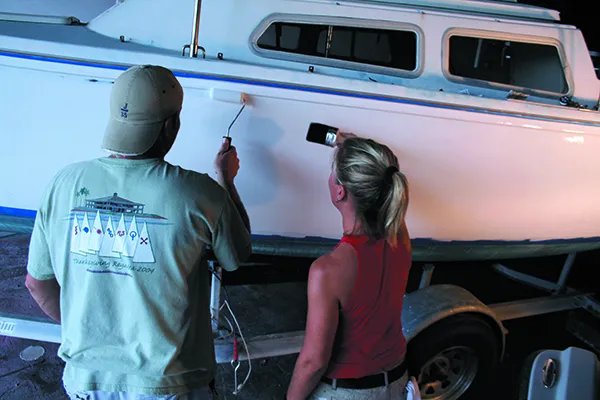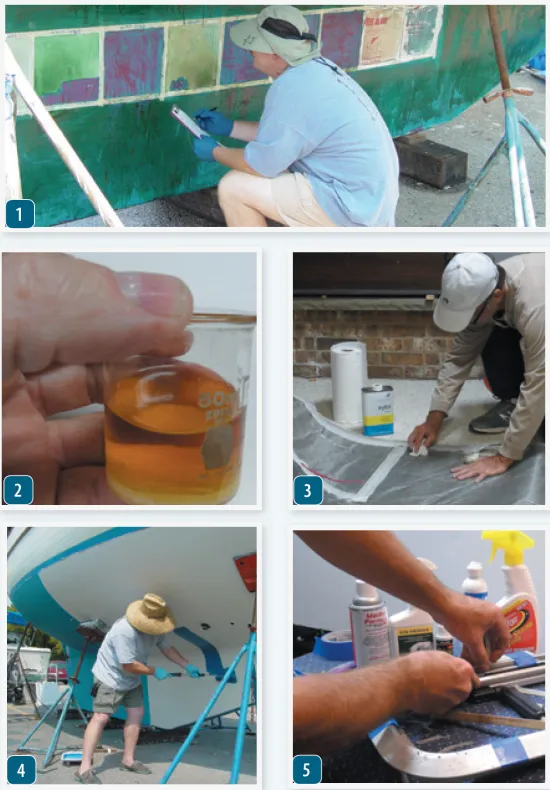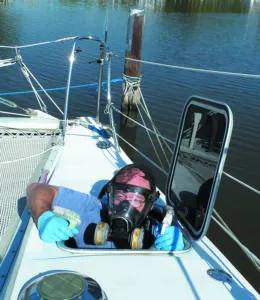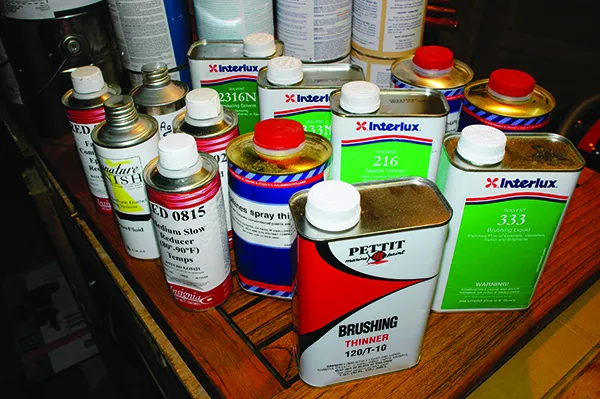We get a lot of chemistry questions, and a common thread lately seems to be the use of replacement solvents and green alternatives. While we’re all in favor of reducing the use of harmful chemicals, the problem with many products marketed as green alternatives is that they are not actually drop-in replacements. Although they can serve some of the same purposes, they fail in key areas, the labeling is often misleading, and they can ruin a project. A few examples:
Problem. My varnish turned lumpy in the can overnight.
Cause: Low-odor mineral spirits was used to thin polyurethane. While the resins are soluble in conventional mineral spirits, low odor mineral spirits has insufficient solvency for some products.
Problem. My bottom paint peeled off.
Cause. While the prior paint type, condition, and preparation are usually the cause, in this case the owner used mineral spirits instead of the more aromatic solvent specified by the manufacturer. Insufficient solvency resulted in poor resin dispersion and slower drying trapped solvent between coats.
Problem. I tried to wipe up the excess polyurethane sealant with mineral spirits, but it just smeared around.
Cause. Odorless mineral spirits is too weak a solvent for the job. Regular mineral spirits works fine.
Pet Peeves
Our pet peeve with these products is that they don’t list ingredients on the label. They call it XYZ substitute and we’re just supposed to trust that the product is what that description implies. Traditionally, the label on a generic product tells you what it is.
Acetone, for example, is acetone. Experience tells us what it can do. An ingredient list is not needed, since it is what it says it is. At the grocery store, we can safely assume the milk came from a cow, and if it is goat’s milk or soy, we expect it to be labeled as such.
Not so with “green” replacements. Only when things go wrong will the DIYer discover that his “green” paint thinner is 65% water. They will open the container and pour a milky emulsion into a can of paint, and immediately ruin it.
If you want to avoid this disaster, you must pull out your phone, in the store, and search for the SDS (formerly MSDS) to learn what the product is, because the label doesn’t tell you. Most solvent ingredients have combustibility, toxicity, or environmental effects that must be disclosed in the SDS, but not all will appear on the can.
While we can’t keep up with the myriad green and replacement substances popping up on the shelves, perhaps we can at least give you the tools to figure out what a replacement can do and whether it fills your need.
KB Values and Drying Rates
Describing the strength of a solvent is a tricky thing. Water can dissolve salt but not asphalt, and mineral spirits can dissolve asphalt but not salt.
The common metric for paint solvents is the kauri-butanol, or Kb value, since it directly relates to dissolving paint resins. In the test, a set amount of kauri gum, a tree resin, is dissolved in n-butanol, which it does easily.
Substitution Cleaners and Solvents
| PRODUCT | MAIN INGREDIENTS | DRYING RATE (BUTYL ACETATE = 1) | KB (KAURI BUTANOL) | COMMENTS | PRICE/GAL. |
|---|---|---|---|---|---|
| GENERIC TSP (C) | Trisodium phosphate | Not applicable | Can mix with bleach for improved cleaning (no reaction); phosphate contributes to algae blooms if discharged | 60 cents | |
| SAVOGRAN TSP SUBSTITUTE (C) | < 5% EDTA | Not applicable | Less phosphate in environment (algae blooms); cannot mix with bleach; and organic ingredients | 37 cents | |
| GENERIC MINERAL SPIRITS(S,C) | Hydrotreated light distillate | 0.1-0.2 | 36-38 | Solvency in paints, better cleaning, faster drying | 10 |
| SUNNYSIDE ODORLESS MINERAL SPIRITS | Hydrotreated light distillate | 0.1 | 29 | Less odor, less effective cleaner, especially polyurethane sealants; dull finish, and slower drying, can make paint gel, particularly polyurethane varnish | 11 |
| KLEEN STRIP GREEN PAINT THINNER (C)* | 15-40% hydrotreated light distillate, 50-85% water, emulsifying agents | <1 | Water-based emulsion is not a solvent; cleans brushes well, but can dull a finish. | 15 | |
| GENERIC VM&P NAPTHA (S,C) | VM&P naptha | 1 | 39-40 | Stronger, faster drying than mineral spirits; useful substitution. | 18 |
| GENERIC XYLENE (S, C) | Xylene | 0.8 | 105 | Strong, fast drying aromatic solvent; useful substitution. | 18 |
| GENERIC TURPENTINE (C) | Turpentine | < 1 | 76 | Strong, fast drying aromatic solvent; useful substitution. | 24 |
| GENERIC ACETONE (S,C) | Acetone | 6 | 76 | Very fast drying polar solvent. | 18 |
| GENERIC BRUSH CLEANER (C) | Acetone, toluene,methanol, glycol ether, tall oil soaps, naptha, ethoxilated amines (proportions vary) | Varies | 60-80 | Cleans all common coatings, including 2-part polyurethanes, do not use as thinner | 18 |
| GENERIC LACQUER THINNER (C) | 30% methanol, 25% acetone, 25% light petroleum distillate, 10% ethyl acetate, 5% glycol ether, 5% toluene | 2-4 | 46-50 | Not tested as a thinner, acetone will likely be just as effective for common cleanup uses | 19 |
| KLEEN STRIP GREEN LACQUER THINNER (C) | 90-95% acetone, 5-10% glycol ether | 6 | Not tested as a thinner; Strong, fast drying aromatic solvent; useful substitution | 19 | |
| GENERIC MEK ACETONE (S,C) | Methylethyl ketone | 1 | 87 | 22 | |
| KLEEN STRIP MEK SUBSTITUTE (S,C) | Ethyl acetate | 4.1 | Slower drying | 25 |
Increasing amounts of the test solvent are added until the solution becomes cloudy, indicating the gum is coming out of solution.
Solvents with extremely high Kb values can behave as paint strippers, softening underlying coatings, so more is not always better. Too low and the resins and pigments will fall out of solution, clump together, and create a gel that cannot be re-suspended. The paint may not bond correctly.
The Kb value can be adjusted by blending solvents so that in aggregate they have the correct properties. Lacquer thinner is perhaps the most familiar example of a blended solvent.
Drying rate is also critical. If the paint dries too quickly you can’t keep a wet edge, self-leveling fails, and the gloss is reduced. Too slowly and thick layers may peel, buckle, or fail to bond, the result of solvent trapped between coats.
Blending can help, but the least potent additive would be regular mineral spirits (Kb about 40). Xylene, with a Kb value of 104, removes polyurethane sealants a little too well for working close to your original bead. Your clean-up effort can liquify the bead you just laid.

A little chemical sleuthing can help you nail down a safe substitute.
Ever pull out a recipe, only to realize you are missing some crucial spice? A quick Google search of “substitutions” will provide a mix of other things that you do have on hand that will produce the same general results. Although our first advice will always be to go with the manufacturer’s recommended solvent, there will come a time when the store is either out of stock or far away, and work must go on. We’re going to over-simplify, but as long as you’re working in small batches, there are generic substitutions that work.
Match solvent type
First, read the safety data sheet (SDS) and spec sheet to learn what solvents were used in the paint and in the recommended solvent. Some of the terms will be vague (petroleum distillate) and often the smell will provide additional clues.
We’re not suggesting sticking your nose in the can, but if it is strong, you’ll notice. If it smells of naptha or xylene, that suggests it is a naphthenic solvents with a high Kari-butanol value (Kb). Or perhaps it smells more like nail polish, which suggests acetone or MEK. If it is sweet and fruity, the more likely solvent is ethyl acetate.
Is it pungent, reminiscent of Formula 409? Then it’s probably glycol ether. The most common glycol ether, ethylene glycol monobutyl ether (also called butyl cellosolve, or EB glycol ether) is available through a number of on-line retailers for about $50/gallon.
Is it nearly odorless? Then the solvent is paraffinic, like odorless mineral spirits. Try to match like with like and mix several things if need be.
Match the Drying Rate
Thinners for two-part coatings must evaporate completely before the coating gels. If not, they will reduce the paint’s hardness. This is why thinning epoxy is generally a bad idea. Trapped solvents can also cause poor bonding.
Brushing solvents must not dry too quickly or the coating will not self-level. It will be impossible to keep a wet edge, critical when trying to roll and tip. Xylene will thin many coatings and it will also dry too quickly for many of them.
Bottom paints, on the other hand, need to dry quickly, particularly when touching up a pad spot while the boat is in the sling. Bottom paint resins typically require a high Kb value to disperse properly. Adding a little xylene can help.
2-Part Paints
We’re going to suggest you stay with the proprietary solvent. The only substitution we are going to suggest is that the solvent for Interlux vs. Awlgrip vs. Imron are generally interchangeable, if you have no choice.
When using a substitution, use as little as possible to minimize any change in coating properties. That said, the substitutions in the adjacent table would be our likely contenders in a pinch.
The same thing can happen with paint and varnish. Add more than a touch of odorless mineral spirits, and the Kb value of the solvent blend drops. As a result, the binding resins fall out of solution. Overnight, this causes lumps in the paint that no amount of stirring will redistribute. If you apply the thinned paint immediately upon mixing, the solvent can interrupt the curing process, affecting gloss and durability.
There has been a dramatic transition away from solvent-based coatings to waterborne coatings. Nearly all automotive finishes are waterborne. But there was an expensive learning curve. Who can forget the rampant automotive paint failures of the 1980s, as makers struggled to get it right?
In our experience, many of the advertising claims regarding water-based substitute solvents are pure bunk, and surely don’t apply to situations involving solvent-based paints. For these claims to be remotely true, the entire paint chemistry must be formulated from the ground up. Even if you don’t botch the job completely, using a water emulsion thinner will result in a dull job that will fail long before its time.
Why the claims? We can only assume that in marketing circles “paint thinner” has become synonymous with mineral spirits, and that people mostly use it for clean up not thinning paint. If that is the case, then it should be labeled as “paint clean-up solvent” and clearly disclose how much water it contains.
We’ve not seen a waterborne varnish we’d use on a boat, although some have been pleased with latex house paint inside lockers. It’s not as durable, but its much easier to work with and all they want is to brighten things up.
Inexpensive Substitutions for Brand- Name Solvents
| BRAND | ITEM | MAIN INGREDIENTS | POSSIBLE SUBSTITUTIONS | PRICE / GALLON | SUBSTITUE PRICE/GALLON |
|---|---|---|---|---|---|
| INTERLUX | 216 Special Thinner (fast dry in cooler climates) | 75% xylene 25% ethyl benzene | Xylene | 60 | 18 |
| INTERLUX | Brushing Liquid 333 (slow dry in hot climates) | 50% kerosene 50% medium aliphatic naptha | 34% mineral spirits, 66% odorless mineral spirits | 69 | 10.66 |
| INTERLUX | Brushing Reducer 2333N (Perfection 2-Part) | 100% ethylene glycol monobutylether acetate | Awlgrip T0031. Awgrip T0005 for faster drying, most 2-part polyurethane autofinish reducers of similar drying time (test first) aka EB acetate | 172 | 35 |
| INTERLUX | 202 Fiberglass Solvent Wash | 25% methyl benzene 25% isobutyl ketone 25% cyclohexanone 25% light aromatic naptha | 35% xylene, 45% MEK or acetone, 25% VM&P naptha | 84 | 18.9 |
| PETTIT | Bottom Prep | 35% xylene 35% isobutyl ketone 10% cyclohexanone 10% ethyl benzene other light aromatics | 50% xylene, 50% MEK or acetone | 68 | 18 |
| SEAHAWK | Wax and Grease Killer | 35-40% xylene 35% mineral spirits 10% ethyl benzene 5% light naptha 1-5% 1,2,4-trimethyl benzene 1% cumene | 66% xylene, 34% VM&P naptha | 37 | 18 |
| PETTIT | Brushing Thinner 120 | 45% petroleum distillate, light aromatic,20% 1,2,4-trimethyl benzene, 20% hydrotreated naptha, heavy, 5% cumene, 5% xylene, other light aromatics | 50% VM&P naptha, 50% xylene | 69 | 18 |
| PETTIT | Spraying Thinner 121 | 75% xylene, 15% ethyl benzene, 3% toluene, 2% cumene, 2% napthalene, other light aromatics | Xylene | 56 | 18 |
| PETTIT | Ablative Thinner 185 | 75% n-butanol, 20% heavy aromatic naptha, 2% napthalene, other light aromatics | 50% turpentine, 50% xylene | 180 | 21 |
| EPIPHANES | Brushing Thinner | Hydrotreated naptha | 34% mineral spirits, 66%odorless mineral spirits | 140 | 10.66 |
MEK Replacements
Acetone and MEK have always been used to cut back gel coat for spraying. The greatest difference is drying time (acetone dries faster). Since MEK replacement is basically acetone with a little ethyl acetate to increase solvency (ethyl acetate is one of the main ingredients in nail polish remover), it will do most of the same things.
Kleen Strip MEK Replacement
Acetone and MEK are interchangeable in many applications, so first determine if you can just substitute acetone. There should be no difference for most thinning and clean-up applications. Common in non-acetone nail polish removers, MEK replacement is ethyl acetate, so ask if it can be used as a replacement solvent. Often it can. It is somewhat lower in toxicity than MEK or acetone, and evaporates faster than MEK but slower than acetone.
Bottom line: A good substitution if it suits your purposes, and less toxic if used for surface prep.
Sunnyside Odorless Mineral Spirits
We poured a portion of polyurethane (Minwax High Gloss) into a smaller can and diluted it slightly with low-odor mineral spirits to increase penetration and reduce brush marks on the early coats. All seemed well and we capped the container tightly.
But when we returned the next day, a semi-transparent gel had formed on the bottom that no amount of mixing would redissolve. Little gel particles just floated around in the container. Needless to say, we didn’t use this diluted mixture on the project.
Starting with a fresh portion of polyurethane, we made the same dilution using regular mineral spirits. I saved some for weeks, just to see, and that mixture remained just as clear and homogenous as the day it was mixed. It is not effective for cleaning polyurethane sealants or solvent-based paints that have dried for more than a few moments.
Bottom line: It works okay for cleaning winches indoors, but it is useless as a thinner.

Nearly every DIY maintenance project has a low-impact, eco-friendly option, but be careful—some “greener” substitutes can set your project back by days, and bring unexpected costs.
- Several “green” chemical strippers designed to peel away bottom paint proved effective in our testing (see “Bottom Paint Strippers, PS October 2006).
- We added 20 percent Kleen Strip Green Paint Thinner to Minwax High Gloss Polyurethane. Within a few hours a thick layer of sludge appeared in the bottom. It became stiff overnight. This thinner may be okay for cleanup, but for application, you should stick to the maker’s suggested thinner, and confirm the chemistry.
- A safe solvent wipe is essential prior to applying sail repair tape to areas that have been lubricated by silicone. Otherwise, the tape adheres poorly.
- Water-based bottom paints make DIY painting far more palatable.
- A port is cleaned for rebedding. A solvent can be so strong that it removes the original protective paint or coating. Always test first.
Kleen Strip Green Paint Thinner
An emulsion containing 30-35% mineral spirits, 65% water, and some emulsifiers. It claims to “contain no hazardous air pollutants.” This is true, since low odor mineral spirits are not defined as EPA hazardous air pollutants— and the rest is water. Home Depot advertising says “The formula is milky-white formula but is safe for use in all colors of coatings.” This is simply not true
We mixed this with Minwax Polyurethane and Interlux Brightside. By morning both had turned lumpy. No amount of mixing would make them into a viable coating again. The gloss on the polyurethane was also dulled, raising serious questions about durability, let alone appearance. And it costs more to boot.
Bottom line: Using a water-based product in place of mineral spirits is a recipe for disaster. Home Depot should know better than to advertise this product for universal use.
Kleen Strip Lacquer Thinner Replacement
Basically acetone with a touch of glycol ether to kick the Kb value up. We’ve never used it with lacquer, so we can’t recommend that use, but as a cleaner it compares to the original.
Bottom line: You probably don’t need to buy this if you have acetone or MEK.

Bottom line: Regardless of the product label or marketing, read the product safety data sheet before using.
A product rated as low-VOC (volatile organic compound) does not necessarily mean it is safe to use without proper personal protection equipment.
Conclusions
The words “replacement” and “substitute” are used interchangeably, and they generally aren’t drop-in alternatives. Many substitute “solvents” are more accurately described as clean-up solvents.
As for DIY substitutions, generic solvents and blends of generics can work, if you check the ingredients. As with cooking substitutions, often you can save a trip to the store if you understand a few formulation basics. Hopefully, we gave you a few tips that will save you money or your project.
With 2-part products, the manufacture-recommended solvent is the smartest choice. It makes no sense to mess up your meticulously prepped and planned topside paint job because you are miffed by the overpriced name-brand solvent. You’re a sailor, not a paint chemist—and a bit of price gouging, it seems, just comes with the territory. If you do buck the system—test first.
Your first reflex when solvent shopping should be to walk past any solvent that does not list the ingredients on the label. Why on earth would we buy a product where the only thing the label tells us is what it is not?
If you like the idea of minimizing the number of chemicals you use for cleaning, maintaining, or repairing your boat, check out these related reports:
The One Bucket Cleaning Kit, May 2017
Four Solvents for Nearly Every Boat Job, November 2019
Boatyard Chemical Wisdom, Practical Sailor July 2017




































Teak oil tests: Do you test for how slippery the oils and varnishes are?
Nice to read an article that points out that much of the “green” malarkey in too many sailing mags is foolishness meant to appeal to the left leaning readers rather than to those of us who actually work on our boats.
I am a “left leaning” boatwright and we just want to make as little impact on our fragile environment as is “necessary”.
I lean to port as well, and I just want good info from sources of integrity like Practical Sailor (thank you Darrell Nicholson). If there’s a choice between something that harms the environment and something that does not, I’m 100% for the latter. I just want the truth, not some exploitive corporation’s “malarkey.”
Wow – you politicized an article about solvent substitutions. Congratulations. Do you feel better having insulted sailors that don’t share your world view?
What is Japanese dryer? It’s a solvent used to speed up drying time? I’ve never used it myself, being a little leery of it’s impact on finish durability, but I’ve been curious.
Great article thanks for dispelling myths about what products contain
Really helpful article!!